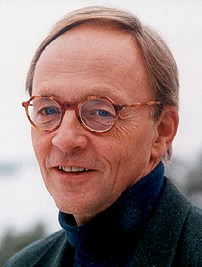A
terrorist attack with nuclear
weapons could be worse
than Hiroshima

By
Gunnar Westberg,
TFF Adviser &
Co-President IPPNW
Sweden - September 21,
2005
Sixty years ago on Aug. 6th the
city of Hiroshima was destroyed by one single atomic
bomb, a weapon produced by the most advanced and
expensive scientific project of its time. Today there are
terrorist groups who in the near future might have the
capacity and the wish to explode a nuclear bomb with the
same terrifying effect as the Hiroshima bomb.
An expert group has for NATO
described and in summary form published a study on the
possibility and consequences of a terrorist nuclear
explosion in a big city. The study was produced by
members of Centre for Strategic and International studies
in Washington and Nuclear Threat Initiative, led by the
former senator Sam Nunn. As example they choose a
detonation in the headquarters of NATO in Brussels,
Belgium. The study, named Black Dawn, was recently
presented for the NATO parliamentarians. I participated
in the presentation as a medical expert.
The scenario: A light covered
pickup truck stops by the main entrance to the NATO HQ. A
nuclear bomb with an explosive power of 10 kilotons,
slightly less than the Hiroshima bomb, detonates. Most
buildings within a radius of 1860 meters will burn and be
destroyed. Humans in this area who are not shielded, e.g.
by concrete walls, will receive from the explosion a burn
injury and a radiation dose with lethal effect within
days or weeks. Many succumb because of fires or are
buried under collapsing buildings.
We calculated that 40,000 persons
die within 24 hours and about 300,000 are severely
injured. Many of the injured will also die, in particular
because the medical resources in central Brussels will be
largely destroyed. The possibilities for transport will
be very small. Rescue teams will because of the radiation
not be allowed to get closer than two kilometres from the
detonation during the first days. The number of severely
burned persons is estimated to be around 30,000. There
are around five hundred beds for burned patients in
northern Europe.
The radioactive fallout downwind
will cover a large area. Tens of thousands of humans,
maybe 60,000, will be subjected to lethal radiation doses
from the fallout. Farming will cease for years in a large
area of Belgium, Holland and North-western Germany. The
enormous economic consequences were not calculated in the
study.
In Hiroshima and Nagasaki the
radioactive fallout was small because the bombs exploded
at a high altitude, while a detonation on the ground will
cause a high radioactivity over a large area.
Can terrorist groups build nuclear
weapons? Yes, the knowledge has become more widely
available, for instance form the Pakistani nuclear
physicist Abdul Khan. His blueprints and equipment have
been sold to several countries, e.g. Iran and Libya and
has also reached Al Qaeda. Terrorist nukes would probably
be "primitive", with a low explosive yield and a higher
weight than in sophisticated weapons, not suitable for
missiles but for a truck or a container.
The crucial step for the terrorist
group is to get hold of uranium of weapons grade, highly
enriched uranium. To build a plutonium bomb is much more
difficult. North Korea has, for instance, tried for more
than a decade. A terrorist group is unlikely to succeed
with this. To produce weapons grade uranium in larger
quantities can only be done with investments of billions
of dollars and access to very advanced technology.
However, there are large stores of highly enriched
uranium in Russia. The reports of substantial thefts from
these stores have not been confirmed. Highly enriched
uranium is also to some extent stored at older research
reactors in many European countries. The amount at each
reactor may be relatively small, of little interest for a
country with a nuclear weapons program, but sufficient
for a single terrorist bomb. In the NATO scenario the
fissile material was assumed to have been stolen from a
reactor in Byelorussia.
In Europe and even more in the USA,
at borders or in harbours, facilities have been installed
at very high cost to check for the transport of
radioactive materials. The expert agreed that these
measures have little chance of success.
The expert group agreed that there
exists a real risk for a terrorist attack with nuclear
weapons within a decade, in Europe or the USA.
Counter-terrorist measures can not be expected to greatly
decrease the risk.
There are however good
possibilities to make nuclear terrorism much less likely.
The important step is to secure all highly enriched
uranium, Europe has great possibilities and
responsibilities here, both supporting the program to
secure uranium stores in Russia and by moving the uranium
from the research reactors to central, well protected
facilities. It is still possible to get all highly
enriched uranium in the world under control.
In a longer perspective the ongoing
nuclear weapons proliferation will be very helpful to
nuclear terrorists. The treaty against nuclear weapons
proliferation, NPT, was severely weakened at the last
review conference in New York May 2005. Several nuclear
powers now threaten to actually use nuclear weapons,
ignoring their pledge under the NPT regime. This will of
course greatly stimulate the efforts by countries that
feel threatened by nuclear weapon states to obtain their
own nuclear weapons. When more countries have nuclear
bombs and nuclear weapons technology it will be
increasingly difficult to stop terrorists from getting or
building them.
To stop nuclear terrorism, or to
stop the much greater danger, nuclear war, there is only
one road: To abolish all nuclear weapons. A large
majority of humans in the world are demanding this, now
at the sixty year anniversary of the atomic bombings of
Hiroshima and Nagasaki.
Never again Hiroshima, through war
or terrorism
Gunnar Westberg
Co-President, IPPNW
Get
free articles &
updates
©
TFF & the author 2005

Tell a friend about this article
Send to:
From:
Message and your name
|